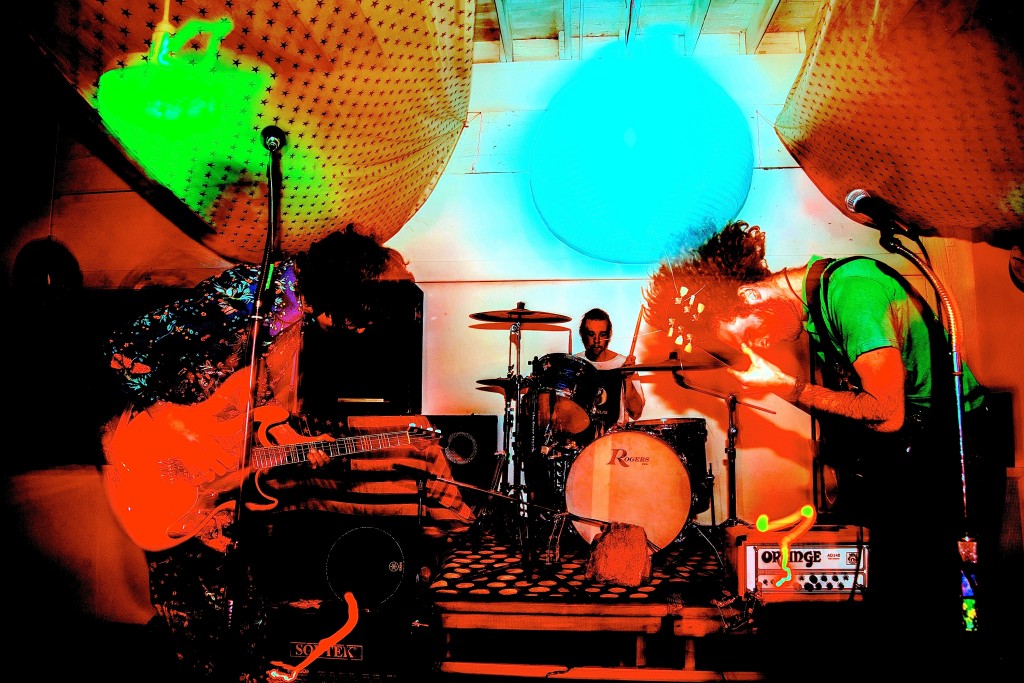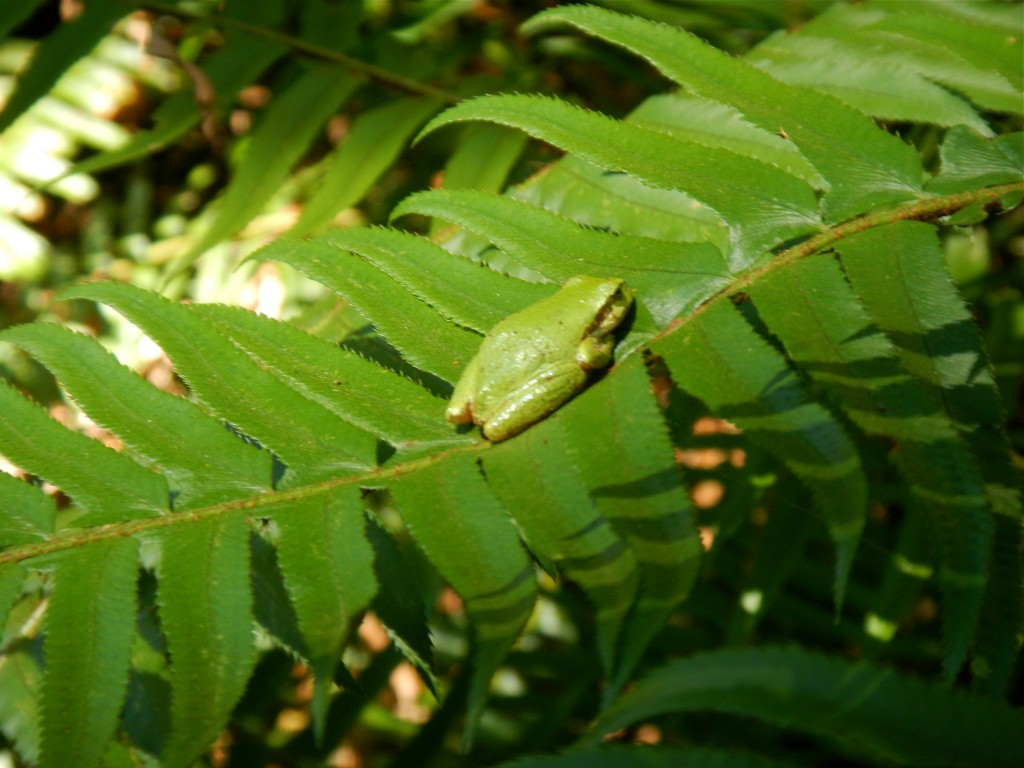Local WEEED Scene On the Rise
April 27th, 2015
 by Christine St.Pierre
by Christine St.Pierre
WEEED is having quite the transformative year—and no, I’m not talking about the recently legalized medicinal herb, although that industry’s not doing too bad, either. I’m following the smoke trails of Bainbridge Island’s homegrown stoner rock band, WEEED, as they blaze through Seattle’s music scene after nearly a decade of grounding their sound in various garages and barns and dimly lit venues along the west coast.
The band’s origin story is like many others: two middle school-aged neighbors (Mitch Fosnaugh and Gabrieal Seaver) develop a deep friendship over their passion for exploring the depths of music. But, unlike most middle school bands that sprout and whither, their story doesn’t end there. Beneath the tall trees and low-lying clouds of Bainbridge Island, a patchwork band of young rockers formed, with the addition of Charlie Powers (former bassist) and John Goodhue (drums), and with it grew the island’s signature music scene, with deep roots that have spread as far north as Bellingham and on south to Portland and San Francisco.
While WEEED is still motivated by original stoner rock gurus like Black Sabbath, Electric Wizard, Ravi Shankar, and Led Zeppelin, they also draw inspiration from the “triple gem” of Buddhism. From the words of bassist/vocalist Gabriel Seaver:
“One who seeks enlightenment can take refuge in three gems of Buddhism and is spiritually fed, inspired and influenced by their qualities. The first gem is the Buddha, the enlightened one, who has attained the perfect state. This can be related to the musicians who inspire us, having attained the heights of mastery.
The second gem is the dhamma, which is the path to enlightenment, the energy that teaches and draws one towards liberation. This can be related to music itself. The act of participating in music is healing, transformational and purifying. In this way it can be seen as a spiritual practice and is self-fulfilling.
The third gem is the sangha, which is the spiritual community. In Buddhism, the sangha is made up of everyone who has attained enlightenment, as well as everyone who is walking the path to enlightenment, especially those walking the path that you have encountered or know personally. The musical community that we have grown with has been huge in keeping us together and dedicated to this journey. We feel infinitely blessed by such a tight, supportive, loving, and truly special community of friends.”
Fostering a “goofy attitude and childlike wonder and play,” WEEED transcends traditional rock by evoking a meditative rhythm laced with experimental guitar, hypnotic drums, and deep, reverberating bass that awakens body, mind, and soul, a sound they identify as “shanghadelic,” seeking to evoke a sense of expansion with the audience as well as within themselves in order to surpass “identification with the mind/body/ego/form/content.” Their mission is well underway; watching WEEED share their live music with others is a meditative experience, where one can simultaneously get lost and found.
“Through the vibrations of music,” Seaver explains, “we hope to fill our audience with love.” And the love is felt, as friends gather to blast-off into an alternate dimension of sound and community, bending and twisting their bodies in a symbiotic emergence while the band thrashes electric onstage beneath rainbow-print suspenders and wild, disheveled hair.
Finding them onstage is about to become a lot easier, too. In the past, magical barn/garage/house shows and small intimate venues hosted a fortunate audience that thrives on community collaboration. More recently, the band signed with Illuminasty Records, a label based out of Portland, San Francisco, and New York, and has plans for a six-week US tour that coincides with the release of their new double LP “Our Guru Brings Us To The Black Master Sabbath,” so pay attention WA, CA, ID, OR, UT, MT, MO, IL, NY, NC, MN—WEEED’s comin’ to town.
Click here to experience some of their jams, or head here to read an entertaining and informative interview by Seattle Weekly.
Where Do We Go From Here?
April 27th, 2015

Contributed by Christine St. Pierre
We arrived at a place where the Pacific spills over the San Juan Islands, creating a Sound worthy of an orca’s song, a place where the foothills of the Cascades roll into the salty blue bay and the lush forests breathe deeply, the moisture on their breath covering the sky with low-lying clouds. The word “green” loses all meaning, as the one color has turned into hundreds of shades, differing not by name but by setting—green like the mossy carpet blanketing the forest floor, or green like the fiery ferns basking in a glimpse of sunlight? When the sky changes, so does green, into warmer, cooler, wetter, bluer shades. The meaning of “green,” conceived as the color between blue and yellow in the spectrum, has hatched into a choice. A green path has been planted where highways and byways once led the people; tiny seeds sprout in the cracked, hot pavement and ivy creeps across intersections like eerie fog before a storm. We have an option—we, the inhabitants of this cosmic sphere, villagers of this dwelling—to choose from Earth’s palette our shade of green, or be left with the blackish brown of an oil spill, the deep crimson of life-blood, the startlingly yellow sign that reads “Warning: Toxic Waste.”
We see it mirrored in cinema and stories: the depletion of our natural resources to the point of vacating the planet, retreating to the stars in search of our next cosmic victim. Children’s movies beg and plead with parents too busy to teach their child the folklore of the Earth. These pictures—with a penguin sent on a great voyage to rescue his species and his artic home, or an ambitious robot determined to bring our overweight, dehumanized race back from space—were created by enlightened adults who have realized something very sad: it is too late for grown-ups. Reach out to the children, teach them young and accidentally; turn the television screen into their subconscious and tell them the truth. And the truth is, we are killing them, our children and theirs. After you, I, we die, they continue to exist. They grow, fall in love, create life, and the cycle continues. Who will grow their food once the land has been stripped of every last nutrient? Who will bring them water when our oceans have acidified? How will they breathe when the skies are thickened with toxic fumes? How many species will be a myth, forests will lay on their side, cancers will surface before we come to a screeching, screaming halt?
Friends, family, we are one. The same sun warms our backs and makes the flowers bloom. The waves crashing against the jutting Pacific coast traveled hundreds of thousands of miles to become a sound bite in your dreams, washing away the ambivalence that plagued generations before us. This existence, your existence, is not accidental. You exist on the brink of history because you are a rainbow warrior, a keeper of the peace, and an artist given the task of painting our future. Choose your colors wisely.

Last week if you visited Pegasus and got a cup of Jo to Go, you’ve probably noticed the new cup lid.
Born out of a passion by former Islanders, the Viora offers a coffee sipping experience that does not resemble your kids’ silly sippy cup
Their conviction “that there was a better way unleashed a scientific curiosity and a maniacal focus that led to years of researching fluid dynamics, evaluating mainstream and alternative plastics, reading research papers on smell and taste, assessing advanced manufacturing technologies, prototyping, and conducting round after round of testing. The result of all this work is the Viora Lid – and a growing collection of patents and patents pending.”
And better yet, it is now being manufactured in the U.S.A.
Benefits:
- Drinks Like a Cup – Tip your cup, and a drink well fills. Sip your beverage over a lip—just as you would if you were drinking from a ceramic cup.
- Unlocks the Aroma – Taste is mostly smell, and the innovative drink well on the Viora Lid ensures a complete taste experience.
- Catches a Splash – conventional lids—when jostled—shoot out jets of liquid aimed for your clothes or dashboard. With the Viora lid, if your drink does splash, it ends up back in the cup rather than on you.
Take a look at the benefits of the lid http://www.vioralid.com/#top and try it for yourself.
We think you’ll love it.